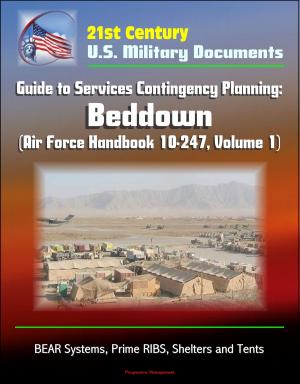21st Century Military Documents: Multi-Service Tactics, Techniques, and Procedures for Defense Support of Civil Authorities (DSCA), Integrating with National Guard Civil Support ATP 3-28.1(FM 3-28.1)
Nonfiction, History, Military, United States| Author: | Progressive Management | ISBN: | 9781311492517 |
| Publisher: | Progressive Management | Publication: | January 24, 2015 |
| Imprint: | Smashwords Edition | Language: | English |
| Author: | Progressive Management |
| ISBN: | 9781311492517 |
| Publisher: | Progressive Management |
| Publication: | January 24, 2015 |
| Imprint: | Smashwords Edition |
| Language: | English |
This publication identifies multi-Service tactics, techniques, and procedures (MTTP) for Defense Support of Civil Authorities (DSCA) and Integrating with National Guard Civil Support. It sets forth MTTP at the tactical level to assist the military planner, commander, and individual Service forces in the employment of military resources in response to domestic emergencies in accordance with United States (US) law. This MTTP focuses on planning, preparation, execution, and assessment of DSCA operations conducted within the US and its territories.
Multi-Service Tactics, Techniques, and Procedures (MTTP) for Defense Support of Civil Authorities (DSCA) and Integrating With National Guard Civil Support (NGCS) describes Title 10, United States Code (U.S.C.), military involvement in DSCA as they operate unilaterally or jointly with National Guard (NG) forces in civil support (CS) environments. Military (operating under all authorities) and civilian after-action reports identify the need for expanded joint military and interagency procedures to enhance military and civil interoperability. For DSCA operations to be effective, active, reserve and NG personnel operating under differing military authority should understand the integration of duties and legal limitations as they interact with civilian agencies at the tactical level.
CHAPTER I - THE HOMELAND AND DSCA OPERATING ENVIRONMENT * 1. Background * 2. Authorities Governing DSCA * 3. Legal Authority * 4. Overview of the National Response Framework (NRF) and National Incident Management System (NIMS) * 5. Overview of the Department of Homeland Security (DHS) * 6. Tiered Response Overview * 7. State Military Response * 8. Federal Military Response * 9. Request for Assistance (RFA)/Mission Assignment (MA) Process * 10. Parallel State and Federal Military Command Structures * 11. Dual Status Command Structure * CHAPTER II - LEGAL CONSIDERATIONS ASSOCIATED WITH DSCA * 1. Background * 2. Posse Comitatus Act (PCA), 18 U.S.C. § 1385 * 3. Permitted Assistance Under PCA * 4. Constitutional Exceptions to the PCA * 5. Select Statutory Exceptions to the PCA * 6. PCA Legal Advisors * 7. Disaster Response * 8. Immediate Response Authority (IRA) * 9. Intelligence Oversight (IO) * 10. Rules of Engagement (ROE) and Rules for the Use of Force (RUF) * CHAPTER III - GENERAL OPERATIONAL PLANNING AND EXECUTION * 1. Planning Considerations in the DSCA Environment * 2. Mission Analysis * 3. Facilities and Support Requirements: Bases, Airports, Ports, or Sea Basing * 4. Reception, Staging, Onward Movement and Integration (RSOI) * 5. Developing Situational Awareness (SA) * 6. Operational Concept/Initial Planning * 7. Evacuation Considerations * 8. Communications Planning Factors * 9. Data Communications Planning * CHAPTER IV - COMMANDER'S CONSIDERATIONS * 1. Overview * 2. Tactical Level Commander * 3. Executive Officer (XO) - could also be Deputy or Chief of Staff (COS) * 4. Personnel/Human Resources * 5. Intelligence * 6. Plans and Operations * 7. Logistic and Resource Management * 8. Communications * 9. Public Affairs Officer/Information Officer * 10. Staff Judge Advocate (SJA) * 11. Religious Support * 12. Medical Officer/Surgeon/Medical Teams * 13. Aviation Officer * CHAPTER V - GENERAL PLANNING FACTORS * 1. Overview * 2. Phases of a DSCA operation * 3. Tactical Level Leadership * 4. Personnel/Human Resources * 5. Incident Awareness and Assessment * 6. Plans and Operations * 7. Logistic and Resource Management * 8. Communications * 9. Public Affairs Officer/Information Officer (PAO/PIO) * 10. Staff Judge Advocate * 11. Religious Support * 12. Medical Officer/Surgeon/Medical/Teams * 13. Aviation * CHAPTER VI - SPECIFIC HAZARD GUIDANCE
This publication identifies multi-Service tactics, techniques, and procedures (MTTP) for Defense Support of Civil Authorities (DSCA) and Integrating with National Guard Civil Support. It sets forth MTTP at the tactical level to assist the military planner, commander, and individual Service forces in the employment of military resources in response to domestic emergencies in accordance with United States (US) law. This MTTP focuses on planning, preparation, execution, and assessment of DSCA operations conducted within the US and its territories.
Multi-Service Tactics, Techniques, and Procedures (MTTP) for Defense Support of Civil Authorities (DSCA) and Integrating With National Guard Civil Support (NGCS) describes Title 10, United States Code (U.S.C.), military involvement in DSCA as they operate unilaterally or jointly with National Guard (NG) forces in civil support (CS) environments. Military (operating under all authorities) and civilian after-action reports identify the need for expanded joint military and interagency procedures to enhance military and civil interoperability. For DSCA operations to be effective, active, reserve and NG personnel operating under differing military authority should understand the integration of duties and legal limitations as they interact with civilian agencies at the tactical level.
CHAPTER I - THE HOMELAND AND DSCA OPERATING ENVIRONMENT * 1. Background * 2. Authorities Governing DSCA * 3. Legal Authority * 4. Overview of the National Response Framework (NRF) and National Incident Management System (NIMS) * 5. Overview of the Department of Homeland Security (DHS) * 6. Tiered Response Overview * 7. State Military Response * 8. Federal Military Response * 9. Request for Assistance (RFA)/Mission Assignment (MA) Process * 10. Parallel State and Federal Military Command Structures * 11. Dual Status Command Structure * CHAPTER II - LEGAL CONSIDERATIONS ASSOCIATED WITH DSCA * 1. Background * 2. Posse Comitatus Act (PCA), 18 U.S.C. § 1385 * 3. Permitted Assistance Under PCA * 4. Constitutional Exceptions to the PCA * 5. Select Statutory Exceptions to the PCA * 6. PCA Legal Advisors * 7. Disaster Response * 8. Immediate Response Authority (IRA) * 9. Intelligence Oversight (IO) * 10. Rules of Engagement (ROE) and Rules for the Use of Force (RUF) * CHAPTER III - GENERAL OPERATIONAL PLANNING AND EXECUTION * 1. Planning Considerations in the DSCA Environment * 2. Mission Analysis * 3. Facilities and Support Requirements: Bases, Airports, Ports, or Sea Basing * 4. Reception, Staging, Onward Movement and Integration (RSOI) * 5. Developing Situational Awareness (SA) * 6. Operational Concept/Initial Planning * 7. Evacuation Considerations * 8. Communications Planning Factors * 9. Data Communications Planning * CHAPTER IV - COMMANDER'S CONSIDERATIONS * 1. Overview * 2. Tactical Level Commander * 3. Executive Officer (XO) - could also be Deputy or Chief of Staff (COS) * 4. Personnel/Human Resources * 5. Intelligence * 6. Plans and Operations * 7. Logistic and Resource Management * 8. Communications * 9. Public Affairs Officer/Information Officer * 10. Staff Judge Advocate (SJA) * 11. Religious Support * 12. Medical Officer/Surgeon/Medical Teams * 13. Aviation Officer * CHAPTER V - GENERAL PLANNING FACTORS * 1. Overview * 2. Phases of a DSCA operation * 3. Tactical Level Leadership * 4. Personnel/Human Resources * 5. Incident Awareness and Assessment * 6. Plans and Operations * 7. Logistic and Resource Management * 8. Communications * 9. Public Affairs Officer/Information Officer (PAO/PIO) * 10. Staff Judge Advocate * 11. Religious Support * 12. Medical Officer/Surgeon/Medical/Teams * 13. Aviation * CHAPTER VI - SPECIFIC HAZARD GUIDANCE















